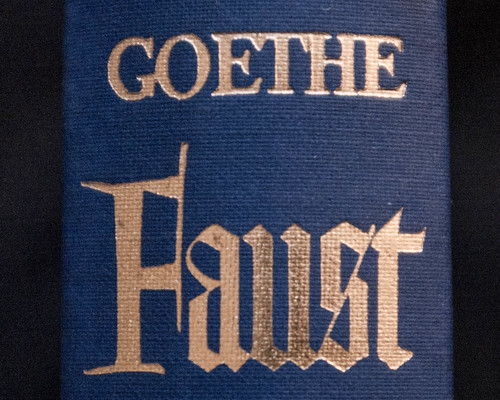I read Goethe’s Faust during my freshman year at Johns Hopkins. Prof. Harold Jantz – “one of the foremost Germanists of his generation” – offered a one-credit course in which that was the only book we read. In English translation, of course. Which was the point of the course, a chance to read one of Western literature’s great books in English translation.
Beyond that, I forget just why I decided to take the course. I’ve got a vague memory that this course was highly regarded – like Prof. Phoebe Stanton’s two-semester introduction to art history – and that’s why I took it. If so, I must have taken it in the Spring semester as I would have had no access to such local knowledge for the Fall semester.
Translated by George Madison Priest
I have little recollection of the course. I believe my friend Peter also took the course, and I remember that Jantz was a relatively short soft-spoken man. I even have a vague memory of a relatively short man in a medium brown tweed suit, with a part in his hair, though he was balding in front. But I wouldn’t put any money on that recollection.
I’m pretty sure I enjoyed the course, but I have no specific memories of it. All I’ve got are these vague memories – but who knows what I would recall under hypnosis? – and the book itself.
We used a 1941 translation by George Madison Priest. Judging from the front matter, it is a revision of a translation that had originally been published in 1932. Priest was born in Kentucky in 1873. He got his bachelor’s and master’s degrees at Princeton in 1894 and 96 at Princeton and then got his doctorate at Jena in 1907.
This translation is thus a very Old School production, Ivy League and the Continent. And one that was praised by no less than Thomas Mann. That’s his endorsement down there at the bottom:
It’s not even in print these days – but you can download it for free from Archiv.org – and it wasn’t mentioned at all when I did a web search on the question, “What’s the best English translation of Goethe’s Faust?” Was Thomas Mann’s evaluation wrong? Have fashions changed in translation? Though I don’t actually know this, the latter is likely the case. But the translation still might be a good one by some credible criterion, just a bit old. As I can’t read German I’m in no position to second-guess Thomas Mann.
Seasonal Melancholia
Why reread the book? One might answer: why not? But that’s not my answer.
I think it’s useful to know that some years ago, while I was still in graduate school, my father told me that he no longer got much pleasure from reading novels. Which we both found strange, as he had been a voracious reader. I figured maybe he wasn’t getting the right novels, and bought some for him as gifts. Humbolt’s Gift was one of them, though I have no particular reason to think he even read it. A think Ironweed was a bit later, but that’s in the land of dim mentation where fabrication may outweigh recollection.
I now know what my father was talking about, at least I think I do. It’s been several years since I’ve had any interest in reading novels. And that’s strange. After all, I got a degree in literature in part because I loved reading novels.
What happened? you ask. Perhaps you’ve been depressed?
Well, a bit. But I’ve been prone to seasonal melancholia ever since I went off to college. And that’s back when I read voraciously. I don’t think melancholia is it.
Why, then?
I don’t know.
Men of Knowledge
But re-reading Faust’s been on my to-do list for the last several years. Why? Faust was a man of knowledge, and sold his soul to the devil for more and keeper knowledge. I’m a man of knowledge, and while I’ve not sold my soul to the devil, I’ve paid a price for my dedication. Or is that obsession? Is there a meaningful difference?
But that’s been changing in the past few years. It started back in 2006-7 when I first got interested in graffiti. That interest is certainly another chapter in my pursuit of knowledge. I’d done considerable work on literature, and more recently had published a book on music (in addition to being a musician). Now it was time to investigate the visual arts, with graffiti as my focus.
To be sure, there’d been the computer graphics book I did with Richard Friedhoff back in the late 1980s. But that was as much about the technology as the images themselves. Moreover, graffiti afforded me a chance to do a different KIND of intellectual work, something I hadn’t done before: primary documentation. While I’ve certainly read about graffiti and blogged a great deal about it, simply photographing the stuff has been by far my major graffiti-related activity. Those photographs are primary documentation of graffiti in a few neighborhoods in Jersey City in the past few years.
During the last years of his life, my friend, colleague, and mentor, David Hays, had undertaken a new kind of work. He’d spent most of his career pursing matters theoretical, but he decided to switch gears and do something doggedly empirical, a review and synthesis of the literature on cultural complexity. If Hays had felt the need to undertake a distinctly different kind of work, then why shouldn’t I do the same?
And that different kind of intellectual activity – documenting graffiti – led me to become involved in my local Jersey City community, first through that Hamilton Park Neighborhood Association, and then when I moved to Lafayette, though the Morris Canal Community Development Corporation. The details of how photographing (illegal) art led me to community involvement are irrelevant here. The basic connection is simple: from art on walls, to the community in which the walls exist. But if you’re curious, though, if you want some stories, the following posts should help: How I Found a Home in Jersey City and Got Steve Fulop Elected Mayor, Part 1, Part 2, and Part 3.
And that brings us back to Faust. In the basic story – which, BTW, is based on the life of a real individual who was a contemporary of Copernicus – Faust dies a miserable death when the devil collects his end of the bargain. But not in Goethe’s retelling of the tale ¬– which must have been the 100th remix of the story. As Goethe tells the story, Faust becomes interested in reclaiming land from the sea and works at that for several years. He dies a redeemed man, with angels proclaiming as they bear his soul aloft (ll. 11,934-41:
Lo! rescued is this noble one
From evil machination;
"Who e'er aspiring, struggles on,
For him there is salvation."
And if to him Celestial Love
Its favouring grace has given,
The Blessed Host comes from Above
And welcomes him to Heaven.
While I don’t see myself headed into land reclamation, I’m moving in a different direction – but more of that in my next post.
Why am I rereading Faust – despite the fact that I’m not much interested in reading fiction? I’m using it as a vehicle to help me turn the corner, tip the tipping point, and move from thinking about the world to changing it.
* * * * *
This image is stamped on the book’s front cover, with nothing in the publishing apparatus that explains what it is. Knopf tells us the “text of this book is is set in Caledonia, a Linotype face designed by W. A. Dwiggins” (p. 427). Dwiggins also “contrived the typographic scheme and designed the binding and jacket.” But about the design on the front cover, nothing.
Of course, it’s the sign of the macrocosm, that’s what it is. How’d I know that? There’s “An Outline and Interpretation” in the front matter, and it mentions that, as the play opens, Faust opens a magic book and sees “the sign of the Macrocosm, the symbol of the universe” (p. xv). That’s got to be what that diagram is, said I to myself. And a bit of web surfing confirmed my hunch.
Given that bit of information, there’s no mystery about why Mr. Dwiggins put it on the cover. But why isn’t there any note telling the reader that that’s what the diagram is?



No comments:
Post a Comment